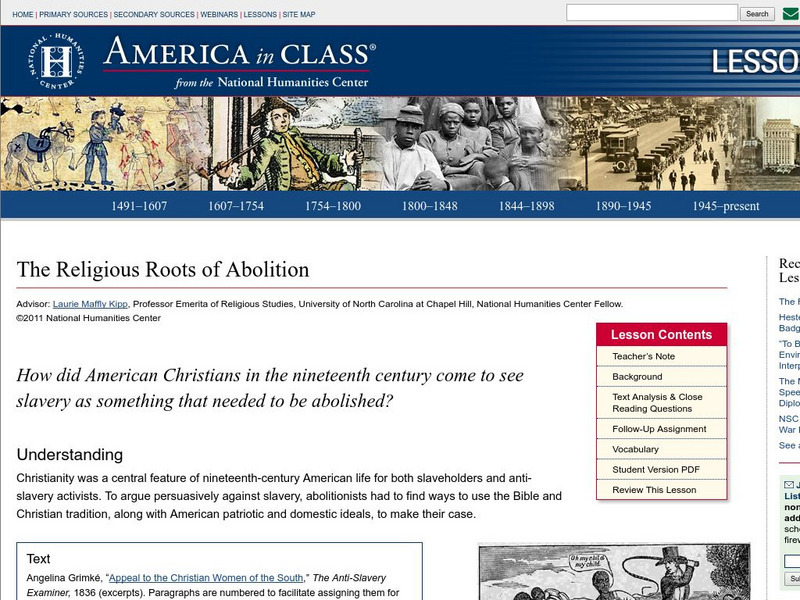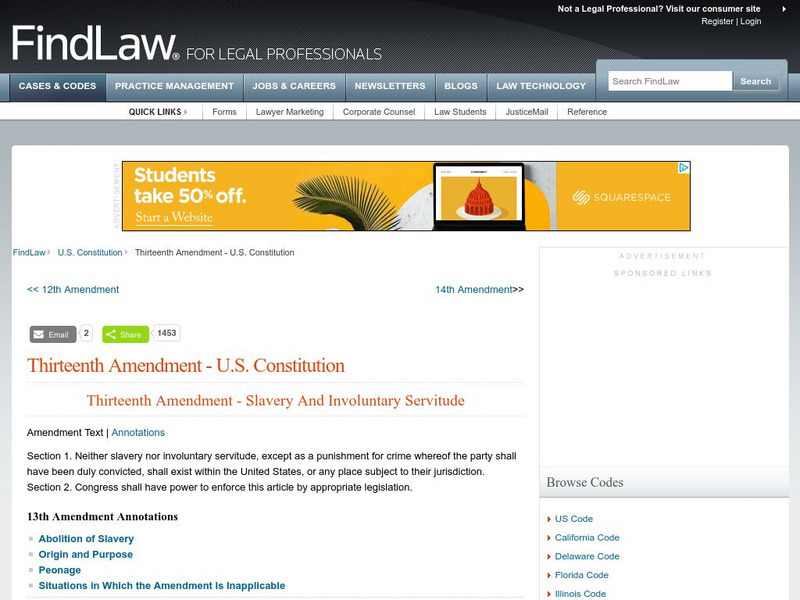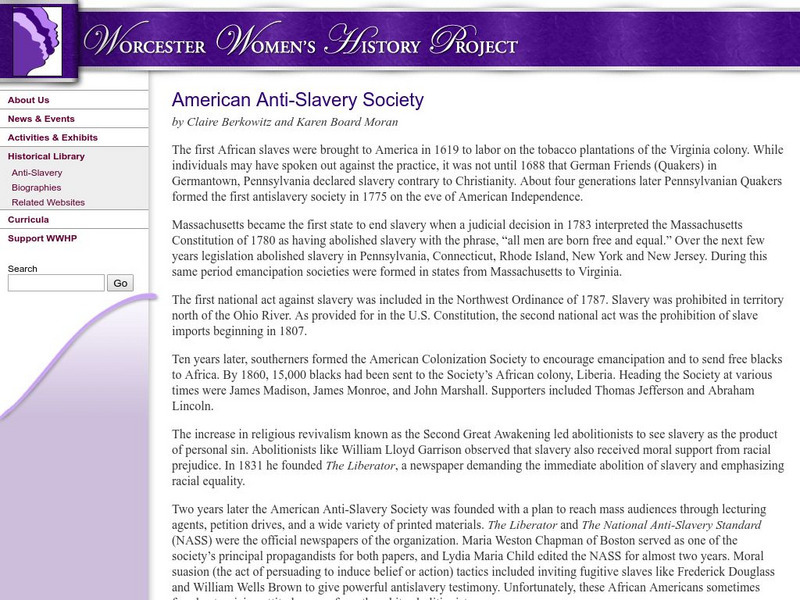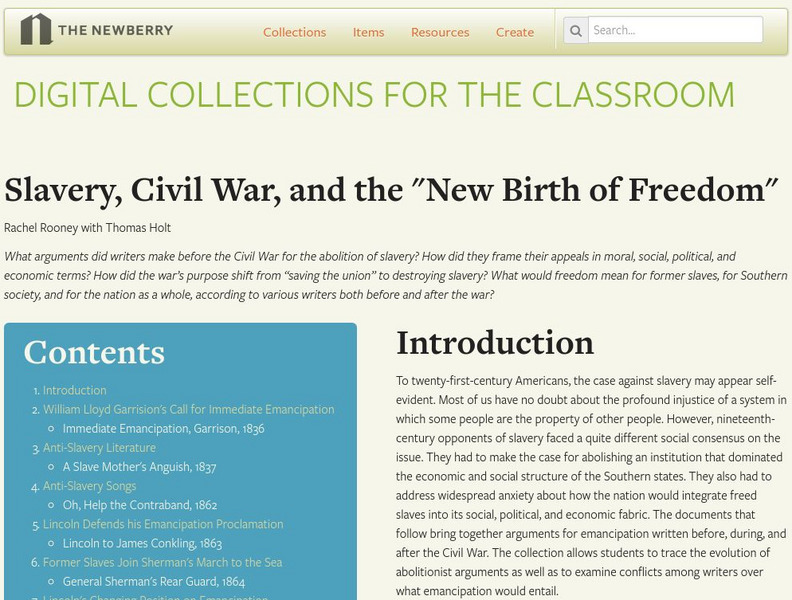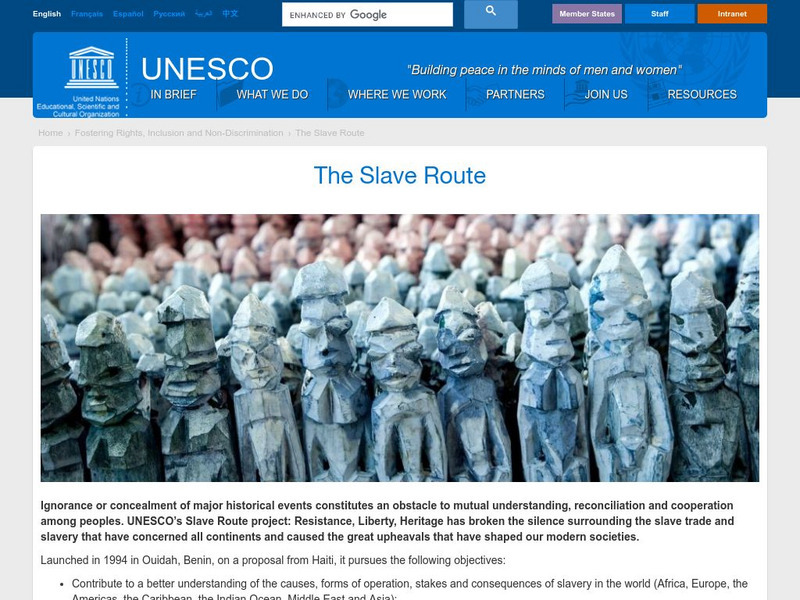A&E Television
History.com: Black History Milestones
A detailed account of the history of African Americans is presented in this article. Divided by main topics or periods of time, the coming of slavery to America is the first focus. Followed by plantation life and escapes to freedom and...
Stanford University
Beyond the Bubble: Slave Quarters
[Free Registration/Login Required] Students examine a photograph of former slave quarters in Georgia and answer questions about the living conditions of slaves. They will also observe how the fact that the photograph was taken decades...
National Humanities Center
National Humanities Center: America in Class: The Religious Roots of Abolition
A lesson that looks at the role of Christianity in the fight to abolish slavery in the United States.
Other
National Maritime Museum: Freedom: Abolition in Britain
Illustrated essay on the abolition of slavery in Britain.
Thomson Reuters
Find Law: u.s. Constitution: Thirteenth Amendment
This source provides the Thirteenth Amendment as it is worded in the U.S. Constitution. At the bottom of the page are annotations with links to information about the abolition of slavery, origin and purpose of the amendment, peonage, and...
Other
Wwhp: American Anti Slavery Society
A good review of the evolution of the support for the abolition of slavery from the first anti-slavery organization formed by the Quakers to the support for Abraham Lincoln as president. Focus is on the American Anti-Slavery Society and...
Khan Academy
Khan Academy: Ap Us History: 1844 1877: The Civil War: Emancipation Proclamation
Discusses the background to the Emancipation Proclamation and how Abraham Lincoln came to support the abolition of slavery and the difficulties that were encountered around this issue. Explains that it did not apply to all slaves as...
Cornell University
Cornell University: Library: I Will Be Heard: The 13th Amendment
Read the text of the 13th Amendment, adopted in January, 1865, even before the end of the Civil War, which ended slavery in the United States. Click on the image to see a larger picture of the document itself.
British Library
British Library: Discovering Literature: Abolition of the Slave Trade and Slavery in Britain
Towards the end of the 18th century, a movement emerged calling for an end to the slave trade and, later, slavery itself. This article traces the road to abolition from the 1780s to the 1830s, highlighting the impacts of grass-root...
Independence Hall Association
U.s. History: Mount Vernon and the Dilemma of a Revolutionary Slave Holder
Read about George Washington's dependence on slaves to increase his wealth, and his private views on slavery. What were the possibilites had he expressed these views in public?
Other
Basd: Reconstruction [Pdf]
A very clear document outlining the various reconstruction plans, the problems for both whites and blacks during Reconstruction, and the amendments added concerning the abolition of slavery, civil rights, and suffrage. Requires Adobe...
Lumen Learning
Lumen: Narrative of the Life of Frederick Douglass, an American Slave
This is the text and audio of the autobiography Narrative of the Life of Frederick Douglass, an American Slave by Frederick Douglass. This 1845 memoir and treatise on abolition encompasses eleven chapters that recount Douglass' life as a...
Yale University
Yale New Haven Teachers Institute: Connecticut Blacks in 18th and 19th Centuries
A curriculum unit that examines the history of slavery in Connecticut, the laws permitting it, segregation, and the struggles faced by freed blacks to achieve equality.
The Newberry Library
Newberry Library: Slavery, Civil War, and the "New Birth of Freedom"
Newberry Library presents primary source materials from which students learn about the arguments made for abolition before the Civil War, how the appeals against slavery were framed, and what freedom would mean for the South and the...
Other
Abolitionists, Free Blacks, and Runaway Slaves: Surviving Slavery in Maryland
Read about the groups of people who lived on the Eastern Shore of Maryland in the mid-1800s and fought against slavery: the Quakers, former slaves, and fugitive slaves. This article describes the efforts of both whites and blacks, who...
National Humanities Center
National Humanities Center: Toolbox Library: Emancipation: Abolition
Speeches, songs, letters, and pamphlets from the early- and mid-nineteenth century promoting the abolition of slavery and emancipation of enslaved peoples are provided within this resource.
Other
Personal Site: Biography of Anthony Benezet
A short but good biography of the famous Quaker abolitionist who established a school for slaves in Philadelphia in 1770. He wrote a pamphlet in 1772 which led to the establishment of the anti-slave trade movement in England.
The History Cat
The History Cat: The Abolitionists
Describes the abolitionist movement and the people who pushed for the abolition of slavery, especially William Lloyd Garrison who founded the Liberator newspaper and the New England Anti-Slavery Society. Arguments for slavery were put...
United Nations
Unesco: The Slave Route
An excellent set of resources on slavery and the slave trade. Looks at artists' perceptions, interviews with historians and others, the Transatlantic Slave Trade, trade in the Indian Ocean, resistance and abolition, trade in the...
Understanding Slavery Initiative
Understanding Slavery Initiative: The Campaign for Abolition
Learn how the anti-slavery movement mobilized the British population to stage the campaign for the abolition of slave trade.
Columbia University
Columbia University:columbia University & Slavery 6.columbians & the Manumission
This website was created by faculty, students, and staff to publicly present information about Columbia's historical connections to the institution of slavery. This article explains the role Columbian's played in the Manumission Society...
PBS
Pbs Learning Media: Harriet Tubman: Abolition Activist
In this lesson plan, by examining two primary sources and watching a short video, students will become familiar with the remarkable bravery and extraordinary accomplishments of the "Moses of her people," Harriet Tubman.
US National Archives
Nara: Treasures of Congress: Struggles Over Slavery the "Gag" Rule
This National Archives and Records Administration site contains John Quincy Adams' response to the "gag" rule in the House of Representatives, May 25, 1836, which restricted discussion about slavery in Congress . Also included are images...
US National Archives
Nara: The d.c. Emancipation Act
Information about, and a scanned copy of page one and five, of the D.C. Emancipation Act which freed slaves in Washington, D.C. in 1862.


